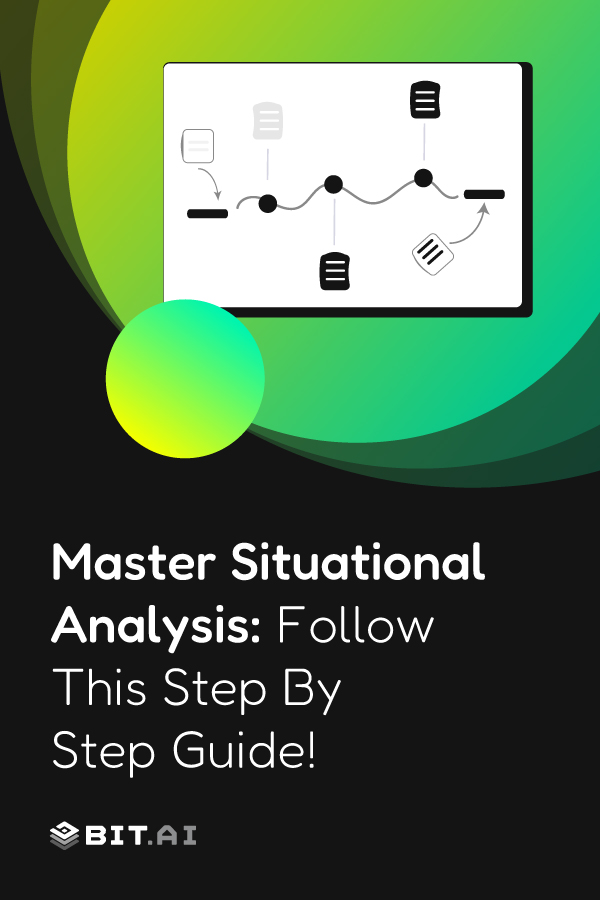Imagine you’ve got a brilliant business idea, the kind that makes you want to jump out of bed in the morning. Your team is on board, the budget is set, and everything seems to be falling into place. But before the big step to launching it, ask yourself—do you really know where your business stands?
Starting a business or expanding into new markets without understanding your current position is really risky. Sure, you might get somewhere, but will it be where you want to go?
That’s where situational analysis comes in. It’s your business’s reality check, a way to figure out exactly what’s working, what’s not, and where you should be heading next. So, what exactly is the term ‘Situational Analysis’?
🚀 Ready to analyze where your business stands? Use Bit.ai to create and share your situational analysis report today!
What is Situational Analysis and why is it Important?
Situational Analysis is a deep dive into both internal factors—things like your sales, market position, and customer base—and external factors like competition, economic trends, and consumer behavior that may impact your business.
A big part of situational analysis is using tools like:
- SWOT analysis (which looks at strengths, weaknesses, opportunities, and threats) and…
- PESTLE analysis (which examines political, economic, social, technological, legal, and environmental factors).
These fancy terms might sound complex, but at their core, they’re just ways of understanding what’s influencing your business, whether it’s inside your company or in the world around you!
Without this kind of analysis, you’re making decisions in the dark. You might have the best product or service, but if you don’t know how your customers feel, what your competitors are up to, or whether there’s a new market trend you should be riding, you’re at a serious disadvantage.
📌 Businesses that skip this step often find themselves wondering why things aren’t going as planned?
On the other hand, businesses that take the time to step back, assess, and strategize can pivot quickly, seize opportunities, and navigate challenges before they become full-blown problems.
It’s not just about gathering data—it’s about using that data to make smarter decisions!
Strategic analysis can help you:
- ✅ Understand your position in the market.
- ✅ Identify key strengths and weaknesses.
- ✅ Recognize opportunities and threats.
- ✅ Develop effective strategic planning for growth.
- ✅ Make data-driven decisions to outshine competitors.
5 Key Components of Situational Analysis
Conducting a situational analysis is like piecing together a business puzzle—you need to understand every part of your company before making strategic moves.
#1 🏢 The Company
Before looking outward, businesses need to start with a self-check. How well is your company performing? Are sales growing? Is your market share increasing or shrinking? A deep dive into sales numbers, revenue streams, competitor positioning, and customer demographics gives you a realistic view of where your business stands.

Think of this as your business’s progress report—it helps determine whether you’re hitting goals or falling behind.
💡 Without this foundation, any strategy you create is built on guesswork rather than solid data.
👉 Also read: Sales Report: What is it and How to Create One?
#2 🛍️ Products and Services
What you offer matters just as much as how you offer it. Is your product or service meeting customer expectations? Do you need to refine your current offerings, or is it time to launch something new?
This is where market research comes in. By gathering customer feedback, survey results, and industry trends, you can uncover gaps in the market and areas for improvement.
💡 After all, a great product that no one needs won’t sell—but a product built around customer insights will always find its market.
#3 🛒 Distribution
Having a fantastic product is just step one—the next challenge is getting it into the hands of customers. Distribution analysis helps determine the best sales channels, whether that’s retail, e-commerce, direct-to-consumer, or third-party partnerships.

This is also where competitor analysis plays a huge role. Are your competitors dominating certain channels? Are there untapped markets you can enter? Understanding the customer journey and buying behavior allows you to optimize your distribution strategy and stay ahead of the competition.
#4 🎯 Opportunities
The business landscape is constantly changing, and stagnation is the enemy of growth. A smart company always keeps an eye on emerging opportunities—whether that’s an underserved market, a new trend, a technological shift, or an evolving customer need.
Situational analysis helps businesses spot trends before they go mainstream, ensuring they can pivot, innovate, and seize new opportunities.
💡 Success isn’t just about reacting—it’s about anticipating what’s next.
#5 🤝 Collaborators
No business operates in isolation. From suppliers and vendors to business partners and distributors, your network of collaborators plays a vital role in your success. A strong partnership can improve efficiency, reduce costs, and increase market reach, while an unreliable one can slow you down.

Evaluating your supply chain, partnerships, and distribution networks ensures that you’re working with the right people.
💡 Building trustworthy, strategic collaborations can give you a significant edge, helping you scale and adapt quickly in an evolving market.
Each of these five components provides a different piece of the puzzle. Together, they create a comprehensive picture of your business landscape, enabling you to make smarter, data-driven decisions. With tools like Bit.ai, this process becomes even smoother, allowing businesses to centralize insights, collaborate in real-time, and track market shifts effortlessly.
5 Easy Steps to Conduct Situational Analysis with Bit.ai
Before we dive into how Bit.ai transforms situational analysis, let’s talk about what Bit.ai actually is.
It’s a workspace where your business documents, market research, team discussions, and real-time insights come together seamlessly, without the need to switch between endless applications. That’s Bit.ai— the smartest AI-Powered knowledge & document collaboration platform designed to make business processes faster, smarter, and more efficient. Whether you’re analyzing trends, drafting reports, or collaborating with your team, Bit.ai gives you a centralized, dynamic space to get things done with ease! Here are some easy steps to follow to do so!
Step 1: Create One Central Workspace
Situational analysis pulls in info from all over—sales numbers, market trends, customer feedback, competitor data… you name it. But when everything’s scattered across folders, emails, or someone’s desktop, things get messy fast.
That’s why the first step is creating a clean, shared workspace in Bit.ai. Here, you can store, organize, and label everything—making it easy to pull up exactly what you need, when you need it.
You can even embed charts, attach PDFs, link to resources, or drop in visuals. Everything stays connected, searchable, and clutter-free. It’s like having a home base for your brain.
Step 2: Collaborate with Your Team in Real-Time
Situational analysis isn’t a one-person job. You need different perspectives—from marketing, sales, product, finance. And waiting days for replies or digging through comment threads? That slows everything down.

Bit.ai makes collaboration smooth and instant. Your team can edit documents together in real-time, leave comments right where they’re needed, tag each other, and even chat without ever leaving the doc.
Everyone’s on the same page—literally. No confusion, no missed input, just faster, smarter teamwork.
Step 3: Let the AI Writer Help You With Everything!
Writing reports or breaking down research can take hours. But with Bit’s AI Writer and Doc Builder, you don’t have to start from a blank page.
Just ask the AI for what you need—maybe a summary of your market data, a competitor analysis, or insights on risks and opportunities. The AI does the work in seconds, turning raw info into clean, and amazing readable content.
You can summarise & refine content, fine-tune it, add your own touch, and yes the best thing….translate it to various different languages too!
Step 4: Start with Easy-to-Use Templates
Not sure how to structure your situational analysis? No problem. Bit.ai comes packed with professional templates—from SWOT Analysis to executive summaries and strategy docs.
Just pick a template, plug in your data, and you’re good to go. Everything is laid out clearly and logically, saving you hours of formatting time. You can also create your own reusable templates that fit your team’s exact process. It’s one less thing to stress over—and everything looks polished from the get-go.
🚀 Make your situational analysis easier with our ready-to-use SWOT analysis template.
Step 5: Build a Living Wiki for Continuous Learning
Situational analysis isn’t a one-and-done task. Your market changes, your competition shifts, customer feedback evolves. You need a way to keep track of it all—without starting from scratch each time.
With Bit.ai, you can turn your workspace into a living wiki. Think of it as your team’s shared knowledge base, where key learnings, updates, and insights are always accessible.
It keeps everyone aligned, saves time on rework, and helps your team grow smarter over time. Future-you will thank you for setting it up.
💡 Pro Tip: Don’t just stop at situational analysis, turn your insights into action! Build with Bit.ai follow-up documents for your Root Cause Analysis and Gap Analysis.
Wrapping Up
Making decisions without a situational analysis is like setting off on a journey without a map—you might move, but not in the right direction.
That’s why taking a moment to reflect, gather insights, and truly understand where your business stands makes all the difference. It’s not about slowing down—it’s about getting clear, so every step forward counts.
With Bit.ai, you don’t have to figure it out alone. From bringing all your data into one place to helping your team collaborate and analyze with ease, Bit makes situational analysis simple, smart, and actually enjoyable.
So before you leap, take a breath. Organize, understand, and then move forward—confidently, strategically, and together. That’s how real progress happens.
FAQs
1. What is situational analysis, and why is it important?
Situational analysis is the process of assessing a company’s internal and external environment to understand its market position. It helps businesses identify strengths, weaknesses, opportunities, and threats (SWOT analysis) while considering economic and industry factors (PESTLE analysis). This ensures strategic planning is based on real data, not guesswork.
2. How often should a business conduct a situational analysis?
It depends on the industry and market dynamics. Most businesses conduct situational analyses annually or quarterly. However, if there are major market shifts, new competitors, or internal changes, it’s wise to reassess more frequently to stay ahead.
3. Can Bit.ai really help streamline situational analysis?
Absolutely! Bit.ai provides a centralized workspace where teams can store reports, collaborate in real-time, integrate with 100+ tools that make work easy as it gets for you!
4. What’s the difference between a SWOT analysis and a situational analysis?
A SWOT analysis focuses on internal strengths and weaknesses, plus external opportunities and threats. Situational analysis, however, takes a broader view, incorporating market trends, competitor insights, and industry conditions. A situational analysis often includes a SWOT analysis as one of its components.
5. Do I need financial data to conduct a situational analysis?
Yes, financial data—such as revenue trends, sales performance, and costs—plays a crucial role. Understanding your company’s financial health in conjunction with market conditions ensures that your strategy is both realistic and sustainable.
Keep Reading & Learning 📚



